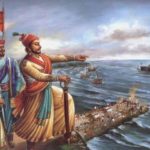This Post in 3 chapters discusses a chain of books that may be of interest to ICP readers.
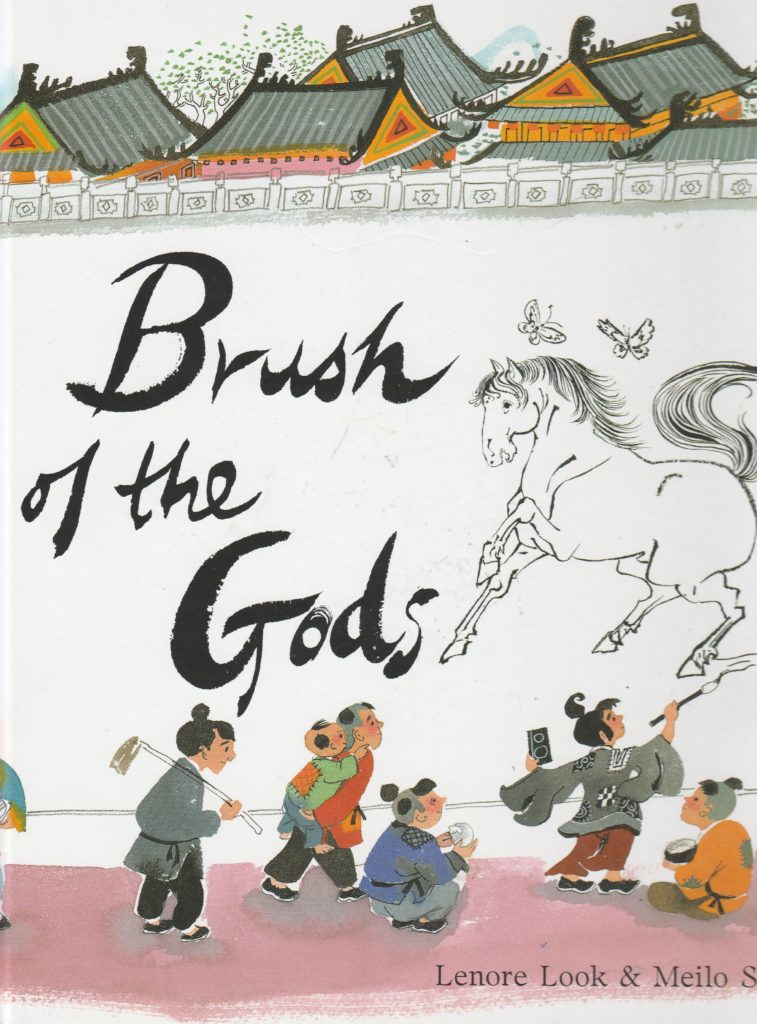
Chapter-1: The Brush of the Gods
‘The Brush of the Gods’ is a children’s book by Lenore Look and (illustrator) Meilo So. Its beautiful illustrations, and words of humor and wisdom, bring to life the work of the great Chinese painter Wu Daozi (Wu Tao-Tzu) who lived in the 7th-8th century CE. Wu Daozi elevated the art of painting to a high position in a land where calligraphy was considered the supreme art.
Lenore Look has authored many delightful books for kids including the ‘Alvin Ho’ and ‘Ruby Lu’ series and has served as an ambassador for native Chinese culture and Buddhist tradition. Her books can be purchased at Amazon and other stores.
Wu Daozi
Calligraphy and its practice bears resemblance to sacred Indian art.
“… the limitation of the written Chinese language is also its strength. Unlike written words formed from alphabets, Chinese characters convey more than phonetic sound or semantic meaning. Traditional writings about calligraphy suggest that written words play multiple roles: not only does a character denote specific meanings, but its very form should reveal itself to be a moral exemplar, as well as a manifestation of the energy of the human body and the vitality of nature itself.” – Dawn Delbanco [8].
The training and practice required to put each symbol to paper is akin to the importance given to the correct pronunciation of every Sanskrit word in ancient India, which helped transmit our sacred Vedic chants over thousands of years with more fidelity than the written word [9].
Lenore Look’s storybook shows how young Wu-Daozi tried his hand at calligraphy and found that his brush had a mind of its own. It invariably produced sketches from nature – animals, plants, birds, forests, waterfalls, and of course, the Buddha.
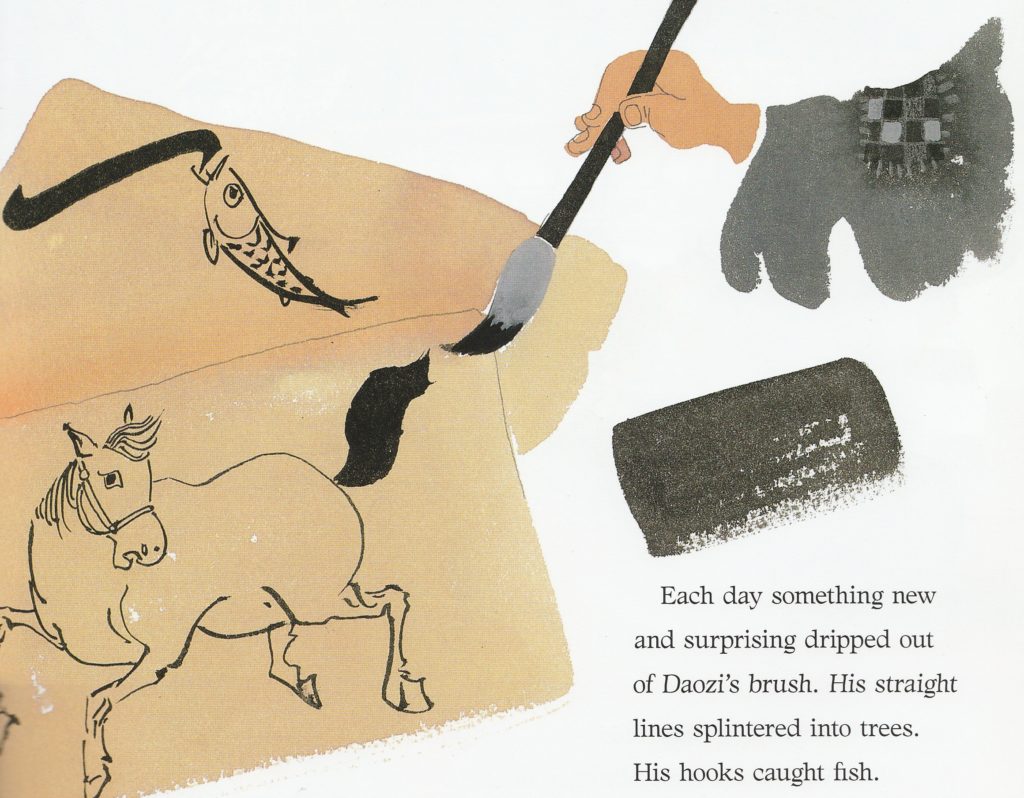
Young Wu began to paint on the walls of the city and produced wonderful works. Admirers began to leave some food for him, which he gratefully took back to share with other monks at the monastery. Then one day, something remarkable happened. He painted a butterfly so fine and real, its wing moved in the wind. He was startled to see it fly away. Wu’s paintings were so full of life, they were indistinguishable from reality! Alas, the animals and birds began to run out of his pictures and the walls were bare again; the grownups did not believe this claim and the crowds began to dwindle. However, the children who forgot their hunger when they watched him, remained.
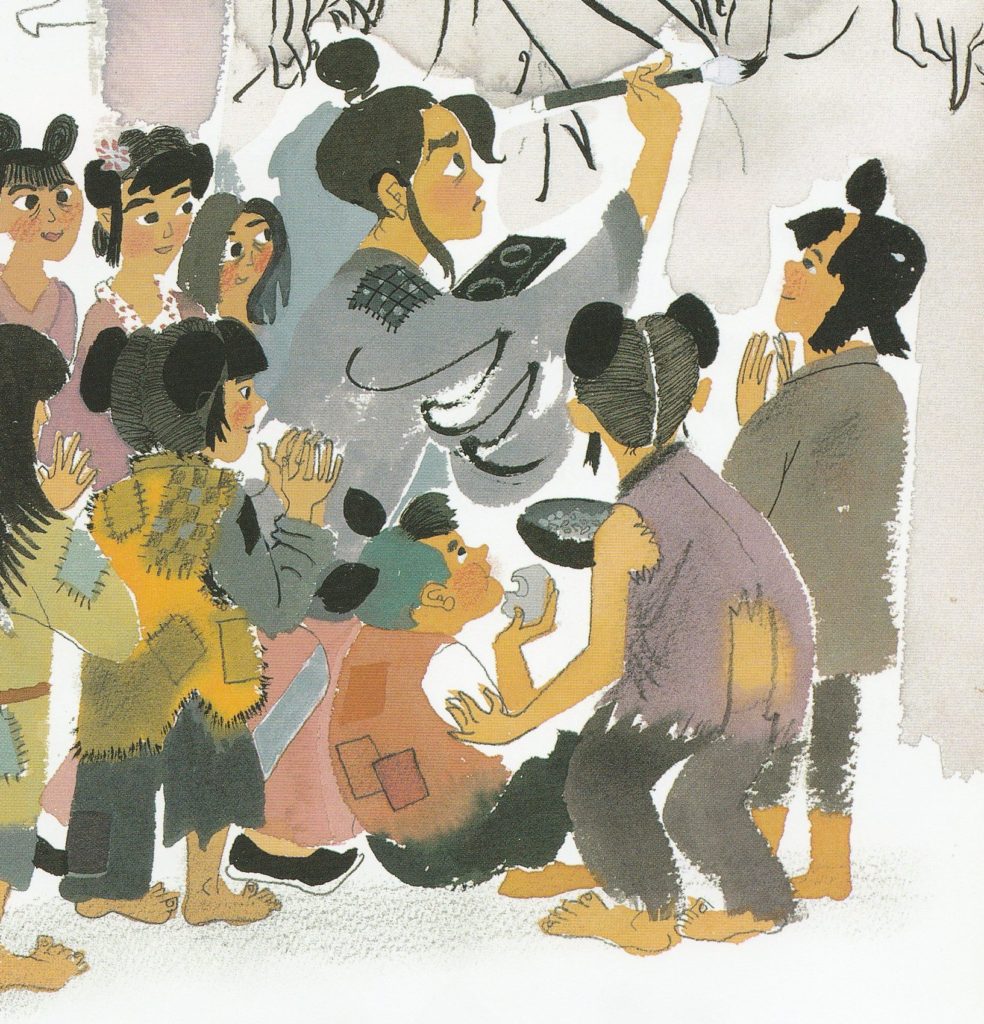
Undaunted, Daozi continued his work and the crowds eventually came back and he became famous all over the land. He was the one who held the brush of the Gods.
The emperor requested him to create a supreme artwork in his palace, a task that required many, many years of dedication. One day it was unveiled to the public. The story goes that this painting had nine thousand, nine hundred and ninety-nine remarkable features to behold. The audience was stunned into silence and the moon wept seeing this work that was “as brilliant as freshly fallen snow”. The audience watched the maestro sketch his final object, an archway, through which he walked right into his painting and disappeared.
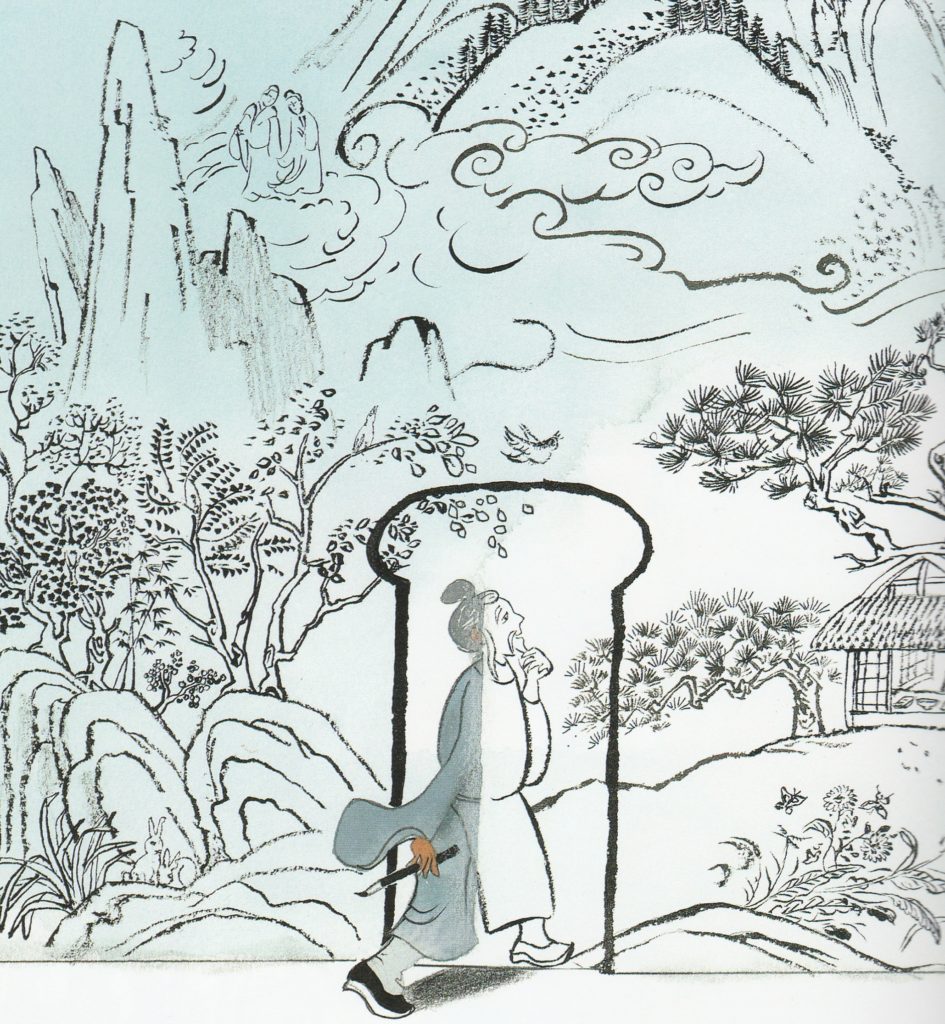
Wu Daozi’s final exit (or entry) has left generations of readers astonished and baffled. Perhaps none more so than Swedish author Sven Lindqvist who made it a personal quest to find if and how one could actually inhabit a work of art. He captured his experiences in the book ‘The Myth of Wu Tao-Tzu‘ (1967) that was recently (2012) translated into English.
Lindqvist: “When I first heard of the tale of Wu Tao-Tzu as a child, entering a picture seemed a very normal thing to do. What else could you do?”
https://youtu.be/mKhKyZgafU4
As he grew older, Lindqvist was more interested in learning how and why Wu Daozi disappeared and where. This quest in the 1950s-60s for answers took him across the world to China to learn calligraphy from the masters, then to India, Afghanistan, and Africa.
Synopsis
"You already know enough. So do I. It is not knowledge we lack. What is missing is the courage to understand what we know and to draw conclusion". - Sven Lindqvist.
- The remainder of Chapter-1 focuses on Lindqvist’s India experience and his book ‘The Myth of Wu Tao-Tzu’
- We return to this in Chapter-3 to tie up the threads in the discussion and conclude.
- Chapter-2 shares excerpts and ideas from two subsequent writings of Lindqvist.
After immersing himself in China’s deep culture and meditative art, Lindqvist is able to absorb the impact of Maoist China (his unsubstantiated conclusion that Maoism was more benign is questioned in this book review). He travels to independent India, perhaps to find affirmation for a youthful understanding of a post-WW2 world being healed by peace and democracy. His conversations with the Nehruvian era politicians began to deflate such optimism.
Lindqvist describes the mindset of a politician from the Congress party he talked to: “It occurs to me that truth and falsehood are to him two sides of the knife, so close. What is important is the edge – power.” The opponent, a ‘radical’ doctor (today’s Krantikari liberal) who defeated the Congress member, was chosen by the corrupt landowners who called the shots. Why? because they knew he wasn’t serious and he knew they knew. He tells Lindqvist: “they support me despite my radical ideas, in order to put pressure on the Congress party – in the exact opposite direction. They support me to stop my ideas being carried out“. A scene right out of Joseph Heller’s Catch-22. The radical wants to live in the world without any contact with it, reminding Lindqvist of the ‘mythical Indian swan which cleaves the water without getting wet‘. His third conversation is with Minoo Masani of Rajaji’s Swatantra party. Masani was no hypocrite but his solutions did not resonate with Lindqvist.
“The British brought peace and order to India. They created a kind of rule of law, but … It made the masses helpless in the hands of those who had the economic and social advantage“.
Nehruvian India soon became the world’s smallest democracy, meant for the empire-nurtured intellectuals and politicians to show their colonial masters how quickly they had learned. The poor of India continued to live in an occupied land.
“There is a simple rule of thumb for anyone in a foreign country wanting to get a rough idea of whether a democracy or dictatorship prevails. When poor people look as if the first thing they expect from me is a powerful kick in the crotch – then I am in a dictatorship“.
Lindqvist contrasts the armed Afghan peasants who were ready to shoot him with the Indians who cringed at his sight.
“I am a pacifist. but after seeing the fear, the mad fright in the Indian eyes, that unnatural abasement both ostentatious and ashamed, but most of all cowed, humiliated, and broken – after having been in India, I am glad to see armed peasants”.

When Lindqvist read the actual history of India, he would discover a continual resistance against multiple occupiers for over 800 years and consuming many millions of lives. Against a savagery only matched by the heroism of India’s warriors, guided by Gurus to uphold dharma and not become the very thing they were fighting.
Lindqvist was unable to forget what he had experienced in India. He talks of the urge of a conscientious visitor to hang oneself in their hotel room in despair. Or should one ignore society and focus on utopian art. But what is the value and meaning of such art? Is art only for the rich and entitled? Does disappearing into one’s art imply an escape from the horrific reality into some make-believe world? Isn’t that what Herman Hesse, son of Christian missionary parents, part-time Theosophist, and the Nobel-winning author of ‘Siddhartha’ tried to do and eventually failed?
Post India, Lindqvist began exploring questions far away from the art domain. What is the nature and origin of this colonialism? What are the roots of genocide? His subsequent writings are among the more devastating critiques of western imperialism and racism to have emerged from the West. Excerpts and observations from two such works, ‘A History of Bombing (2003)’, and ‘Exterminate All the Brutes (1992)’, are discussed next. Any emphasis in bold are mine.
Chapter-2: The Brush of the Demons
The laws of war have always answered two questions:
When may one wage war? What is permissible in war?
And international law has always given two completely different answers to these questions, depending on who the enemy is. The laws of war protect enemies of the same race, class, and culture. The laws of war leave the foreign and the alien without protection.
When is one allowed to wage war against savages and barbarians?
Answer: always.
What is permissible in wars against savages and barbarians?
Answer: anything.
- Sven Lindqvist, A History of Bombing.
The brushes used by the demons include theology, technology, and modern science.
Theology
Some historians attribute the genocide of the Jews to the intense anti-Semitism of Hitler. Other western intellectuals deem it a unique Nazi German act. Some in Western Academia looked eastward for the motivation. Lindqvist makes a case that the most convincing explanations are found by looking westward, in Europe, that beacon of democracy, science, and technology.
“The Germans have been made sole scapegoats for ideas of extermination that are actually a common heritage”.
"The word Europe comes from a Semitic word that simply means "darkness"".
What were the European rules of war in the middle ages?
“… a distinction ·was drawn between Bellum Hostile, war between Christian knights, and Bellum Romanum, war waged against outsiders, infidels, barbarians, or insurgent peasants. Bellum Hostile was conducted according to chivalric code and followed strict rules. Bellum Romanum was lawless war. ”
Compare this to the Hindu principles of Dharma Yuddham [more precisely termed as, Achara Yuddham] explained in the video below, which were recognized from the ancient times to right until the ‘civilized’ Europeans brought their Bellum Romanum to India.
These rules of engagement were refined by Hugo Grotius (1583–1645) as Lindqvist notes, but it did not apply to rebels, infidels, and savages. When the European powers wanted open land, prior sanction for mass murder of savages (to clear inhabited land) was available within the very works that broadly shape European deep culture:
“The Puritans arrived in Ireland and America with the Bible in hand. The Bible backed them up. They simply acted in accordance with the commandments of the Lord as stated in the verses of chapter 7 of Deuteronomy:
When the LORD your God brings you into the land which you are entering to take possession of it, and clears away many nations before you, the Hittites, the Girgashites, the Amorites, the Canaanites, the Perizzites, the Hivites, and the Jebusites, seven nations greater and mightier than yourselves;
And when the LORD your God gives them over to you, and you defeat them; then you must utterly destroy them; you shall make no covenant with them, and show no mercy to them ..
And you shall destroy all the peoples that the LORD your God will give over to you, your eye shall not pity them …
And he will give their kings into your hand, and you shall make their name perish from under heaven; not a man shall be able to stand against you, until you have destroyed them.
From the beginning, genocide is inscribed in our culture’s earliest and holiest texts. Read the Old Testament. Read the Iliad. Read the Aeneid. There are your instructions. ”
Extermination of savages was justified by theology in the middle ages and later using secular science. Labeling the Hindus ‘Kafirs’ and ‘Heathens’ is sufficient for organized religion to suspend such rules and wage Jihad or conversion-crusades against India.
Author's note: 'Justification' is not just another dictionary word. It emerges from the history-centric core [9] that defines Christianity (i.e., Nicene Creed). Wikipedia definition: "In Christian theology, justification is God's act of removing the guilt and penalty of sin while at the same time making a sinner righteous through Christ's atoning sacrifice".
“.. a legal declaration in which God pardons the sinner of all his sins and accepts and accounts the sinner as righteous in His sight. God declares the sinner righteous at the very moment that the sinner puts his trust in Jesus Christ (Rom. 3:21-26, 5:16; 2 Cor. 5:21).”
…. Sinners are justified through faith alone when they confess their trust in Christ. We are not justified because of any good that we have done, are doing, or will do. ” [11].
Material gains obtained through theologically justified violent means. Europe’s populations violently moved into every other continent.
Back to Lindqvist.
“Thomas Malthus… In the second edition of his most important work, ‘Principles of Population’ (1803), he writes that it is quite possible to solve Europe’s food shortages temporarily by exterminating the native populations of other continents;”
During the long period of comparative peace that Europe enjoyed between 1815 and 1914, the area under European control grew from 35% of the earth to 85%. - Sven Lindqvist, A History of Bombing.
In 1869, a British imperialist like Charles Dilke could maintain in his bestseller ‘Greater Britain’ that “The gradual extinction of the inferior races is not only a law of
nature, but a blessing to mankind.””
“… in his classic Military Manners and Customs (1885), [James Anson Farrer] says that war between peoples with different standards of civilization does more to barbarise the civilised than to civilise the barbarous population.”
Perhaps Lindqvist experienced in India how a barbarized and terrorized people react when approached by a foreigner from ‘the civilized land’.
Technology
The annihilation of entire peoples and tribes in Africa, South America, and Asia was made possible by overwhelming firepower – from the rifle to the machine gun, and then artillery guns mounted on steamships that sailed into the interior-most rivers to unleash their fury on bow-and-arrow wielding natives. Within a decade of the Wright Brothers first flight, aerial bombardment of the ‘savages and brutes’ commenced and was employed from Africa to the northwestern border of India.
“The first bomb dropped from an airplane exploded in an oasis outside Tripoli on November 1, 1911.”
Long before WW2 began, the European colonists had decades of target practice on the ‘savages’ of the world.
“The machine gun was the weapon of choice in colonial wars. It was used throughout the world to educate uppity natives. The climax came at the battle at Omdurman in 1898. There the English lost forty-eight men, while more than 10,000 Sudanese were left on the battlefield, mowed down by the rapid fire of the British rifles and machine guns….
… no Sudanese got closer than three hundred yards from the British positions.” Their soldiers had perfected the civilized art of killing from a distance.
Winston Churchill, who would later preside over that crime against humanity that left 4+ million Indians dead in the Bengal ‘famine’ of 1943, was at Omdurman. Lindqvist quotes Churchill hailing the event as “the most signal triumph gained by the arms of science over barbarians“. The slaughter influenced Kipling’s racist poetry. By 1919, the British did not even need their own soldiers. Colonel Dyer’s sepoys mowed down unarmed fellow Indians – men, women, and children at Jallianwala Bagh from a safe distance. Not just land and labor, the Indian mind was taken too.

Victor Gillam – “The White Man’s Burden (Apologies to Rudyard Kipling)” Judge, 1899, Public Domain.
It became “possible for even a lone European traveler to practice almost unlimited brutality“. The dum dum bullet was used to stop the savages who couldn’t be stopped by regular bullets. Its use against the soldiers from “civilized states” was prohibited. After repeated massacres, many natives simply surrendered, so glory-hunting soldiers provoked them into unequal battle to claim bragging rights and battle ‘honors’ back home. When the mass murders got out of hand, planted news reports exaggerated the ‘barbaric rituals’ of the natives to justify the actions and shift the focus away from the huge numbers of natives murdered.
Lindqvist's book title comes from Joseph Conrad's novel 'Heart of Darkness' (1899). The central character, Kurtz's final document explaining his civilizing mission in Africa ends with a postscript: 'Exterminate all the Brutes!'.
When King Leopold of Belgium exterminated millions in Africa, “the great powers had little desire to interfere with Leopold’s genocide, for they themselves ..“. In his 2005 Lettre Ulysses Award keynote speech [8], Lindqvist explained how the authorities in Belgium still live in denial about the Congo genocide; that the Tervuren Museum of Central Africa “now admits that murders and mass murders did happen, but emphasises that they never were sanctioned by the highest Belgian authorities. No, of course not. The highest authorities in every country always prefer to look the other way.
The number of deaths has been wildly exaggerated, claims the Museum. It cannot be proved that ten million Africans met a violent death under King Leopold’s rule. Perhaps it was a mere 2 million. And all of them were not murdered outright. Some of them might have been worked to death, others starved to death, when the colonial regime requisitioned their food-stores and their labour. But since they were not actually murdered, there was, according to the Museum, no genocide.“
A Belgian Indologist employed this argumentation to educate Hindus that the deaths of several millions in the Bengal ‘famines’ in 1943 wasn’t really a genocide.
Lindqvist summarizes his finding: long before Hitler, European colonialism had already consumed several million lives.
“what Hitler wished to create when he sought Lebensraum in the east was a continental equivalent of the British empire“.
Modern Science: Racism and Darwinism
The Third Reich and the British Raj used the Aryan invasion theory and the idea of a superior Aryan race to support their actions. Lindqvist cites Hannah Arendt’s work ‘The Origins of Totalitarianism’ (1951) that “showed how imperialism necessitated racism as the only possible excuse for its deeds“. The clinching scientific validation for imperialism and genocide of the savages came from the modern theories of evolution. Pioneers of these theories did not condemn genocide, or the racism used to justify it:
- 1790s: Georges Cuiver, a scientist, came up with the early modern race theories. He had a mania for order. He divided human beings into three races, compared the negroid race to primates, and attributed to them a ‘state of total barbarism’.
- 1832: Geologist Charles Lyell admired Cuiver’s works and his passion for order. He wrote “Principles of Geology”, which included the chapter “Extirpation of Species by Man”.
- 1859: Charles Darwin took Lyell’s book on HMS Beagle and wrote his famous ‘Origin of Species’. He studied Cuiver and corresponded with Lyell.
Darwin wrote to Lyell about his own idea of ‘biological patricide’: Revolutions wipe children out, whereas evolution terminates parents. This process results in “the less intellectual races being exterminated” and also “at some future period not very distant as measured in centuries, the civilized races of man will almost certainly exterminate and replace throughout the world the savage races“. Lindqvist is not sure what exactly Darwin meant by ‘savage races’. Darwin’s theory “gave exterminators an alibi that extermination is inevitable … genocide began to be regarded as the inevitable byproduct of progress“. Armed with modern science, 19th century western scholars began to refer to native peoples and tribes as “living fossils”.
Robert Knox took these ideas to the next level to call for the extermination of native history and tradition. Lindqvist states his views: ‘China appears to be totally at a standstill with neither inventions nor discoveries. The famous Chinese art must belong to another race from which the Chinese borrowed it without really understanding it’. This claim mirrors the equally bogus Aryan Invasion Theory that Sanskrit and Vedas came from a superior Aryan race in Europe which the less-capable, native Indians consumed [6]. Lindqvist cites Frederick Farrar (1886): Aryans and Semites were deemed the master races, Chinese ranked as ‘semi-civilized’, while the rest were irreclaimable savages “without a past and without a future“.
Indian commentator S. Gurumurthy mentions how Karl Marx labeled India ‘semi-barbarian’ without even setting foot there. As Professor R. Vaidyanathan has remarked, the rest of the world only worries about an uncertain future, but India additionally contends with an uncertain past. A past dismembered by colonialism and racism.
Lindqvist notes that “as a young student, Darwin heard his [Knox’s] lectures. As far as these racist theories, “Darwin neither confirmed nor denied them, but his origin of species theory was clearly useful for the racists… after Darwin, race became the wholly decisive explanation in far wider circles – became the central element in British imperial ideology…. after Darwin, it became accepted to shrug your shoulders at genocide …. Darwin was eyewitness to massacres and tortures by the European military (for example, in Argentina). “He called it “the struggle for life” and yet he believed it developed and ennobled the species of man“.
Darwin’s cousin, Francis Galton worked on related topics (he introduced Eugenics) and there is no such ambiguity in his writings. The path-breaking book ‘Breaking India‘ [6] discusses the impact of Galton’s and other works from an Indian perspective, and is generous to Darwin (“used the word ‘races’ to mean ‘varieties’ and not human races“). Lindqvist is unforgiving and his findings raise questions about Darwin’s role in the birth of racism. Darwin’s theory of evolution should be taught, but along with a history of the racism it produced.
“Darwin was forestalled by those who parroted him, and he seems to have been seduced by their highest bids” – Sven Lindqvist.
Lindqvist quotes Winwood Reade painting an idyllic picture of a ‘post-genocidal’ world:
“a grateful posterity will honor the memory of the blacks.One day young ladies will sit tearfully beneath the palm trees and read “The Last Negro” And the Niger will be as romantic a river as the Rhine“.
Since the savages of the world were doomed, the urgent scientific task was to collect information about these ‘dead men walking’ for posterity. Lindqvist explains how racism created the subfield of Anthropology where western scientists could gather data about the savages regarding their “physical and moral characteristics in the interests of science“. As Dharampal accurately pointed out [7], Anthropology and Western Indology are not too different:
“The work of the indologists is in fact akin to anthropology. Anthropology, as recognised by its practitioners, is a peculiar science of the West. The defeated, subjugated and fragmented societies of the non-Western world form the subject of this science. Anthropology thus is the science of the study of the conquered by the conquerors. Claude Levi Strauss, an authentic spokesman and a major scholar of anthropology, defines his discipline more or less in these terms.”
Genocide
“You can read about a thousand atrocities, but you only have to see one. Suddenly it is your brother there” - The Counterfeit Traitor (1962).
Lindqvist: “The words “concentration camp“, invented in 1896 by the Spaniards in Cuba, anglicized by the Americans, and used again by the British during the Boer war, made their entrance in German language and politics”. This happened when Germany joined the European tradition in 1904, annihilating the Herero people of Southwest Africa, following the North American model (used to erase 90% of the native Americans within 100 years).
Geographer and Zoologist Friedrich Ratzel was a German anthropologist who applied these advanced ideas to his areas of expertise. He linked the “biological theory of life with the geographical theory of space” to derive ideas like Lebensraum (1897). Lindqvist notes that his book was read by Adolf Hitler while writing ‘Mein Kampf’ in prison; after uniting the millennium old theological tradition of antisemitism with the new scientific European tradition of genocide, Hitler’s plans move from mass murder to genocide. The primary goal was not simply to kill all the Jews he hated, but through their extermination, free up space, eliminate unnecessary resource consumption, and increase Germany’s Lebensraum.
Auschwitz was the modern industrial application of a policy of extermination on which European world domination had long since rested.
- Sven Lindqvist in 'Exterminate All The Brutes'.
Lindqvist’s search for Wu Daozi and the meaning of inhabiting art brought him face to face with the desperate reality of lives outside Europe and a broken world at odds with his assumptions. Is there any hope at all? His works offer no definitive resolution. For this, we must return to India where his inner search began.
Chapter-3: The Brush of Dharma
“India of the ages is not dead nor has she spoken her last creative word; she lives and has still something to do for herself and the human peoples. And that which must seek now to awake is not an anglicised oriental people, docile pupil of the West and doomed to repeat the cycle of the occident’s success and failure, but still the ancient immemorable Shakti recovering her deepest self, lifting her head higher towards the supreme source of light and strength and turning to discover the complete meaning and a vaster form of her Dharma.” – Sri Aurobindo.
Lindqvist hoped to find a union between an inner and outer world. In the ‘Myth of Wu Tao-Tzu‘ he wonders if he would ever regain what he had lost – “that feeling of meaning and justification tradition once provided“. Would he become a person who lives in the world without contact with it?
“Is the function of art to make mass graves banal? Is it the task of thought to make starvation uninteresting? Spiritual happiness that makes the world irrelevant will also make suffering, oppression, and extermination irrelevant“.
“What was it that happened in India? I seriously began to doubt my own judgment and the judgment of all my contemporaries”.
He saw in India people whose will was broken, and dignity snatched. He learned how the Jews simply walked to their doom without fighting back and their neighbors were silent. Resistance by the first group of Jews or their neighbors may have planted enough doubt in the minds of the Nazis about the cost and scalability of their insane plans and saved many lives. Yet they simply walked, and others kept quiet.
He who says nothing. He consents He who whispers. He lies He who screams. He goes unheard. - Sven Lindqvist, The Myth of Wu Tao-Tzu.
A gentle reminder for Indians who feel ‘resistance is futile’ or remain fence sitters.
After his return from India, Lindqvist continued his manthan about the growing problems outside Europe in contrast to the optimism of post-war reconstruction inside Europe. He found a global system hopelessly biased in favor of the same colonial powers. These powers voluntarily limiting their wealth and power was the one solution he saw and immediately dismissed as impractical.
Lindqvist never mentions meeting any of the masters of dharma tradition in India. These traditions were the source of Wu Daozi’s Buddhism. Lindqvist’s writings allude to sacred Hindu art (‘Indian Raga‘ and dance) and its ‘tremendous possibilities’, but he does not explore it further. Hamsa, the vehicle of Devi Saraswati, which Lindqvist mentions as ‘the mythical swan’ does not represent a world negating existence. Its qualities remind me to strive to attain a higher consciousness required to fulfill my duties in this transactional world without getting attached to its material rewards. Hamsa gives us Viveka, the ability to discriminate between valid and false knowledge, sham and real spirituality. He or she who through their spiritual practice and experience attains a supreme level of consciousness like Sri Ramakrishna, is revered as a Paramahamsa.
Modern artists in India who moved away from dharma also grappled with the duality of art and reality, artist and citizen, inner and outer world, truth and joy. The example of how the great Indian poet Sumitranandan Pant [10] returned to dharma is worth reading.
“Like Sri Aurobindo the poet also believed that true spirituality should not mean a repudiation of external reality. It should irradiate and impregnate the external reality and make it more meaningful and oriented towards God. Sham spirituality should be replaced by true spirituality which takes as its junior partner the social reality. The later poems of Sumitranandan Pant give expression and celebrate the union of the outer and inner worlds….His poems are verbal artifacts containing warm human experience. They are neither intellectual exercises nor philosophical abstractions“.
Thus, to a practitioner of a dharma tradition, Wu Daozi’s final transcendental act may not seem baffling or out of place. Meera’s story ends with her merging into the Murthi of Sri Krishna, uniting with the immanent divine. Thyagaraja was a contemporary of Mozart. Both were musical geniuses but Thyagaraja’s sacred compositions represent a quest for self realization and are steeped in Rama Bhakti, and capable of transcending the dualities generated by the synthetic unity of western thought.
All major dharma thought systems including Buddhism, affirm an integral unity. Vedanta expresses this as the “one Ultimate Reality that is Supreme Consciousness and that there is nothing independent of this reality [9]”. Rather than escape reality, this integral approach to music, dance, and literature used the brush of dharma to embrace and uplift the people of a brutally occupied nation and in the process, scaled incredible aesthetic and artistic heights.
Lindqvist was not the first person from the West to point to India’s impending demise. Despite all odds, the future looks more hopeful today for India’s poor masses than ever before. Unlike the European powers, this is not being achieved by violent land grab, slavery, extermination, or mass exploitation. Ancient India voluntarily limited its desire for riches and spread dharma and sanskriti rather than embark upon a world conquest. She remains the guardian of the infinite brush of dharma that paints an inclusive world that anyone, through shraddha and saadhana, can experience and inhabit in peace.
ॐ सर्वे भवन्तु सुखिनः।
सर्वे सन्तु निरामयाः।
सर्वे भद्राणि पश्यन्तु।
मा कश्चित् दुःख भाग्भवेत्॥
References:
- Lenore Look and Meilo So (Ilustrator). The Brush of the Gods. Schwartz & Wade. 2013.
- Sven Lindqvist. Myth of Wu Tao-Tzu. Granta Books. 2012.
- Dawn Delbanco. Chinese Calligraphy. 2008.
- Sven Lindqvist. A History of Bombing. The New Press. (2003).
- Sven Lindqvist. Exterminate All the Brutes. The New Press. (1992).
- Rajiv Malhotra and Aravindan Neelakandan. Breaking India: Western Interventions in Dravidian and Dalit Faultlines. Amaryllis. 2011.
- Dharampal. Collected Writings in 5 Volumes. Other India Press. 2000.
- Sven Lindqvist. Lettre Ulysses Award Keynote Speech. 2005 (English).
- Rajiv Malhotra. Being Different : An Indian Challenge To Western Universalism. Harper Collins. 2011.
- B. N. Prasad. Sumitranandan Pant. http://www.yabaluri.org.
- Guy Waters. What Are Justification and Sanctification. 2015.
